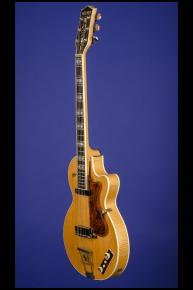What do Eric Clapton, David Gilmour and Justin Hayward all have in Common?
They All Owned and Played a Hofner Club 60…
1959 Hofner Club 60 Blonde (Selmer)
This rare 'Blonde' Club 60 weighs just 4.10 lbs and has a thirteen inch wide, two inch thick, semi-hollow body, lightly arched single-cutaway body. Two-piece natural spruce top (Hofner decal in gold with black trim on upper bass side) with a two-piece book-matched highly-flamed maple back. The sides of the body are also nicely flamed. Single bound five-piece (maple-mahogany-beech-mahogany maple) neck with a scale length of 24 1/4 inches, a nut width of just over 1 9/16 inches and a very fat 'baseball-bat' profile. On the back of the headstock, stamped in blind is the serial number "685". The top of the body has seven-ply binding and the bottom has five-ply binding. Single-bound ebony fretboard with 'triple-layer' nut, 'zero' fret and 22 (refretted) jumbo frets with inlaid three-piece mother-of-pearl position markers. Ebony faced headstock with Inlaid mother-of-pearl "Hofner" and inlaid mother-of-pearl 'vine leaf' decoration'. Later individual closed-back tuners with hexagonal metal buttons. Two Hofner single-coil pickups with black bakelite cases on height-adjustable matching bases with outputs of 6.28k and 6.16k. Original tortoiseshell pickguard with silver trim, secured by one pin into the side of the neck and a metal bracket attached to the treble-side of the body. Two volume controls plus three 'slider' switches, all on rectangular tortoiseshell panel (edged in white) on treble bout. White plastic with gold top Hofner 'teacup' control knobs with securing grub screws. Hofner ebony bridge on ebony base with six individually adjustable individual saddles (actually lengths of fretwire). Hofner 'trapeze' tailpiece. Taking into account the changed tuners (an upgrade) and the expert re-fret, this rare little guitar is in excellent plus (8.75) condition with just a miniscule amount of light belt-buckle scarring on the back (nothing through the finish) and a few very small surface marks on the spruce top. Housed in a later five-latch, shaped black hardshell case with red plush lining (9.00). When we purchased this guitar the neck pickup was rather thin sounding - so we sent it to our expert Hofner luthier Don Butler. Don arranged for Kent Armstrong to restore the original pickup to its former glory. The neck pickup now sound great - full and fat…
"A smart newcomer to the famous "Club" range, with a slick "stagey" appearance. Designed on "semi-acoustic" principles, with fully vaulted back. The Club 60 is fitted with the "New Line" flick action change console, two Hofner high sensitivity pick-ups, adjustable bridge for height and tuning compensation. Smart mother o' pearl embellishments, carefully embedded nickel-silver frets" 1959 price list shows "No. 442 Club 60 Brunette 40gns." (1959 Hofner catalog).
"The Club series of guitars are probably those most considered to be the Hofners that helped the early British rock heroes in their early careers. Photographs abound of John Lennon, Paul McCartney, Dave Gilmour, Justin Haywood, etc. clutching a Hofner Club in their youth. The Club was considered by most young guitarists in the late 50s to be the "business", until they were weaned away by such modern developments as the Futurama III or, if really lucky, an American guitar! There were three Club models to choose from in those days; the Club 40 with one pickup and modest timbers and ornamentation. The Club 50 was its two pickup equivalent, but the real McCoy was the Club 60, with beautiful flamed timbers, ebony fingerboard, and extravagant inlay work to headstock and neck. Despite a resemblance, in shape and size, to the Gibson Les Paul, the Clubs were of hollow construction using laminated timbers, and hence considerably lighter than the Les Paul. The tops were finished with spruce and back/sides flame maple, the two-part back being book-matched on the 60. Although the top was arched, the back was flat; again possibly an attempt to emulate the looks of the Les Paul? The usual Hofner blonde (natural) and brunette (sunburst) finishes were offered on all Club versions. The neck on the Club 60 is of five-part construction, maple/mahogany/beech/mahogany/maple, capped off with an ebony fingerboard. The Clubs were much played in British rock bands during the late 1950's and early 1960's, with the Club 60 being seen in the hands of John McNally of The Searchers, and a young David Gilmore." (The Vintage Hofner website).
This is a similar model to one of the first guitars that Eric Clapton owned, which he bought from a shop in Surbiton called Bells. Clapton recalled seeing this model as the top of the range guitar in the Hofner catalogue when he was 13 years old. (Eric's guitar fetched $27,600 at the Christie's 'Crossroads' auction in 1999)
David "Gilmour is most commonly associated with Fender Stratocaster and Telecaster guitars, but one of his earliest and most fondly remembered was a Hofner Club 60. "The Club 60 wasn't actually the first guitar I had, but it was the first one I finally settled with after two or three others.… " Gilmour's Club 60 was one of the early, 'black pickup' models - "I didn't like the humbuckers" he says…" (Gordon Giltrap & Neville Marten. The Hofner Guitar - A History, pp. 34-35).













